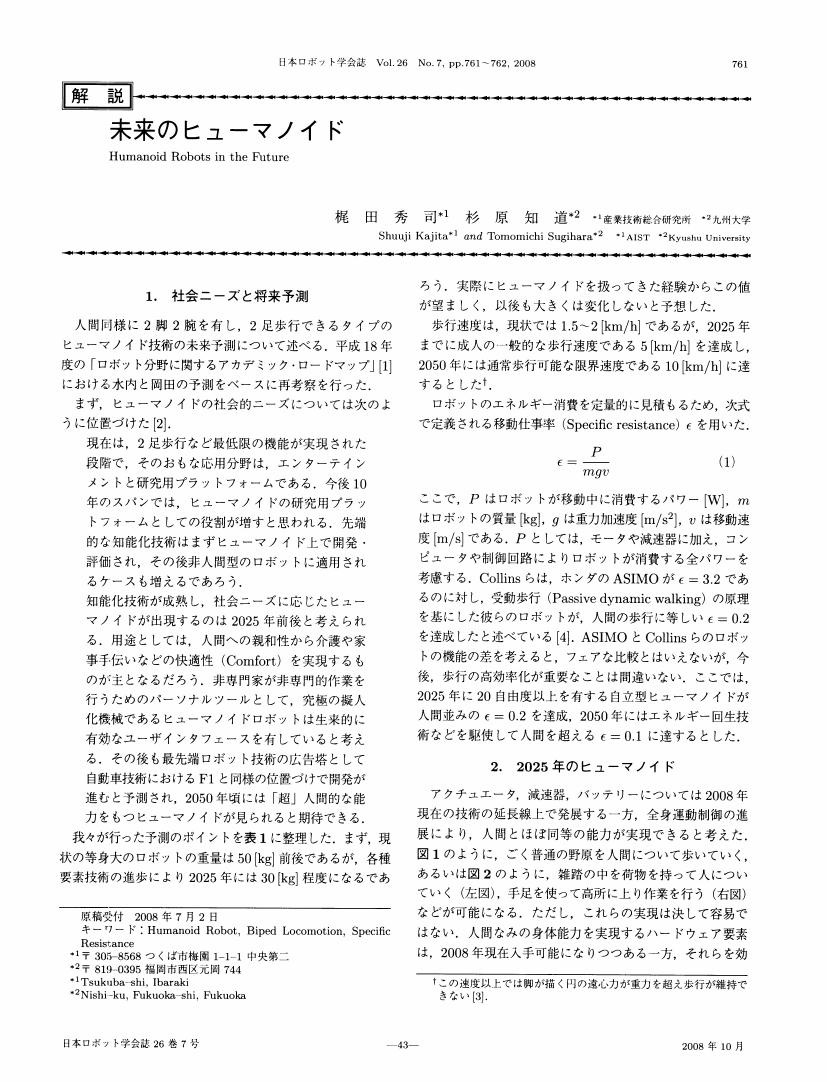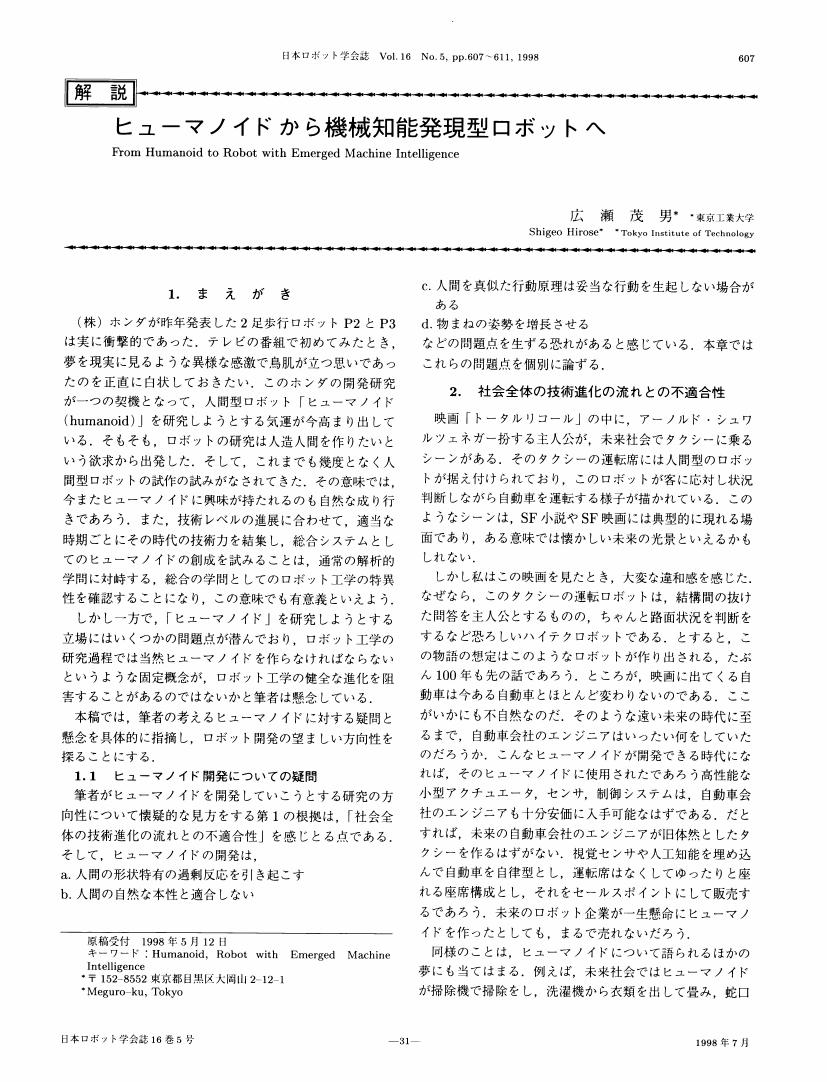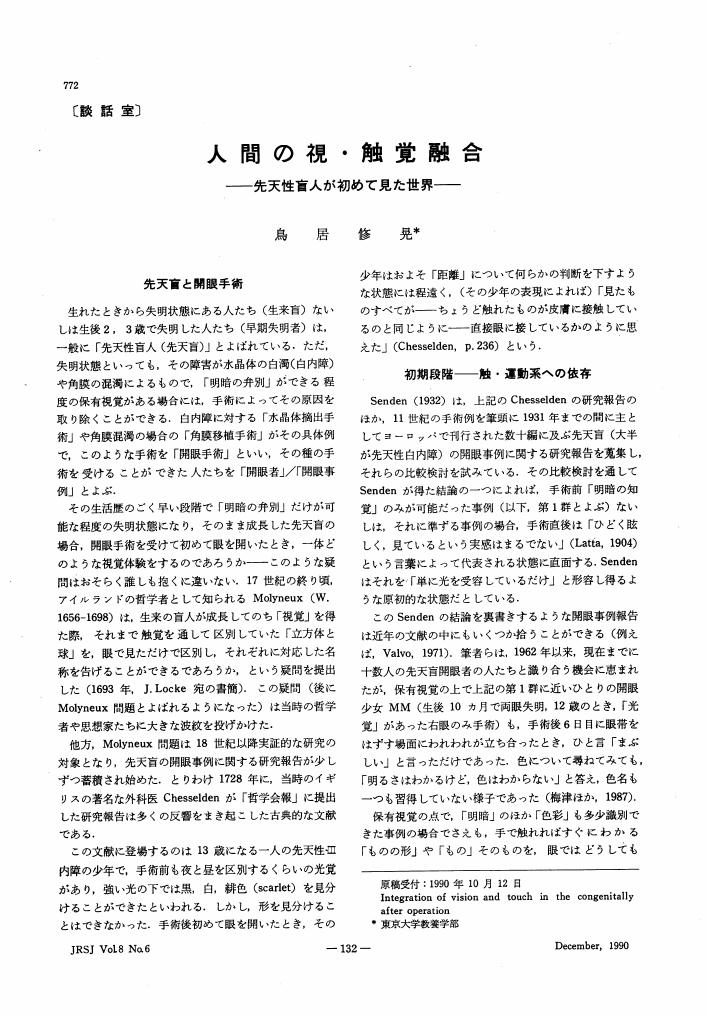25 0 0 0 OA 未来のヒューマノイド
21 0 0 0 OA ロボット制御への身体図の導入
- 著者
- 森 政弘
- 出版者
- 日本ロボット学会
- 雑誌
- 日本ロボット学会誌 (ISSN:02891824)
- 巻号頁・発行日
- vol.1, no.1, pp.13-16, 1983-04-30 (Released:2010-08-25)
18 0 0 0 OA テレイグジスタンスにおける視覚情報提示系の設計と評価
- 著者
- 舘 章 荒井 裕彦
- 出版者
- 日本ロボット学会
- 雑誌
- 日本ロボット学会誌 (ISSN:02891824)
- 巻号頁・発行日
- vol.7, no.4, pp.314-326, 1989-08-15 (Released:2010-08-10)
- 参考文献数
- 6
- 被引用文献数
- 6 5
人が直接作業を行うのが危険な作業環境下でロボットに作業を行わせるなどの場合, オペレータが直接そのロボットの存在する場所で作業をしているような臨場感を有して現場の状況を把握し作業を行えることが望ましい. そのようなテレイグジスタンス (Tele-existence) システムを構成する重要な要素の一つとして, 臨場感の高い視覚情報の実時間提示システムがある. このシステムの実現方法として, オペレータの頭の動きを実時間計測し, それに基づいて配置や大きさを人のそれらと同等にした両眼のテレビカメラシステムを実時間制御することによって, 人の網膜上に実際の環境を直視しているのと全く同一の2つの2次元画像を常時提示し臨場感を生じさせる方式を提案し, 試作装置により有効性を確認した. さらに, 心理空間を定曲率のリーマン空間で近似し, 人の直接視による空間知覚と提示装置を介した空間知覚とを定量的に比較し, 装置の臨場感を評価した.この画像は自然色で提示され, かつ頭の運動を空間の自由度と同一の自由度として拘束感なしに, 視野の拡大を可能とする臨場視覚情報提示システムとなっている.
16 0 0 0 OA ヒューマノイドから機械知能発現型ロボットへ
- 著者
- 広瀬 茂男
- 出版者
- 日本ロボット学会
- 雑誌
- 日本ロボット学会誌 (ISSN:02891824)
- 巻号頁・発行日
- vol.16, no.5, pp.607-611, 1998-07-15 (Released:2010-08-25)
- 参考文献数
- 4
7 0 0 0 OA 人間型ロボットの片足立脚動作における全身を用いた実時間動バランス補償
- 著者
- 田宮 幸春 稲葉 雅幸 井上 博允
- 出版者
- 日本ロボット学会
- 雑誌
- 日本ロボット学会誌 (ISSN:02891824)
- 巻号頁・発行日
- vol.17, no.2, pp.268-274, 1999-03-15 (Released:2010-08-10)
- 参考文献数
- 12
- 被引用文献数
- 2 19
We have developed a balance compansating method for dynamic motions of a full-body humanoid standing on one leg. This method could compensate tri-axial moments in any motions, using all joints of body in real-time. In this method, costraint conditions for stable motion were calculated by using physical 3D model of the robot, and the output motion was determined by solving an optimization problem so that the output should be closest to the input under the constraints. The proposed method had high generality because of independence of joints arrangement of robot. This paper describes the algorithm of the method and an experiments applied on the 16D. O. F. humanoid in kick motion.
7 0 0 0 OA 人間の視・触覚融合
- 著者
- 鳥居 修晃
- 出版者
- 日本ロボット学会
- 雑誌
- 日本ロボット学会誌 (ISSN:02891824)
- 巻号頁・発行日
- vol.8, no.6, pp.772-774, 1990-12-15 (Released:2010-08-25)
- 参考文献数
- 14
5 0 0 0 OA カオスの制御
- 著者
- 潮 俊光
- 出版者
- 日本ロボット学会
- 雑誌
- 日本ロボット学会誌 (ISSN:02891824)
- 巻号頁・発行日
- vol.15, no.8, pp.1114-1117, 1997-11-15 (Released:2010-08-25)
- 参考文献数
- 11
5 0 0 0 OA 等身大ヒューマノイドロボットの後方転倒制御の実現
- 著者
- 藤原 清司 金広 文男 梶田 秀司 横井 一仁 齋藤 元 原田 研介 比留川 博久 五十棲 隆勝
- 出版者
- 日本ロボット学会
- 雑誌
- 日本ロボット学会誌 (ISSN:02891824)
- 巻号頁・発行日
- vol.23, no.4, pp.427-434, 2005-05-15 (Released:2010-08-25)
- 参考文献数
- 13
- 被引用文献数
- 2 3
This paper investigates a method through which a human-size humanoid robot can fall over backwards safely. Squatting-extending motion of legs reduce impact of falling and shock-absorbing parts of the robot keep the force at a permissible range. The robot could stand up itself again after falling.
5 0 0 0 OA 人間型ロボットの近未来応用
4 0 0 0 OA ロボットの研究者は現代のからくり師か?
4 0 0 0 OA ロボット事始とロボットによる創造性教育
3 0 0 0 OA 多足歩行ロボットの世界
3 0 0 0 OA リリスボット―生活支援ロボット―の構想
3 0 0 0 OA ロボットの移動機構に関する研究動向
- 著者
- 山下 淳 淺間 一 新井 民夫 太田 順 金子 透
- 出版者
- 日本ロボット学会
- 雑誌
- 日本ロボット学会誌 (ISSN:02891824)
- 巻号頁・発行日
- vol.21, no.3, pp.282-292, 2003-04-15 (Released:2010-08-25)
- 参考文献数
- 98
- 被引用文献数
- 6 22
The wheeled robot's ability is one of the most important factors which is influential with efficiency of achieving tasks by robots. Demands for mobile robots change where environment and purpose does, therefore various mechanisms of mobile robots are proposed. However, there is no standard or general guideline of designing moving mechanisms. In this paper, we classify and denote characteristics of moving mechanisms systematically, and indicate the guideline when we design them. Especially we describe omnidirectional robots and irregular terrain robots.
3 0 0 0 OA 3D荒地用歩行ロボットの研究
- 著者
- 有川 敬輔 広瀬 茂男
- 出版者
- 日本ロボット学会
- 雑誌
- 日本ロボット学会誌 (ISSN:02891824)
- 巻号頁・発行日
- vol.13, no.5, pp.720-726, 1995-07-15 (Released:2010-08-10)
- 参考文献数
- 11
- 被引用文献数
- 2 7
The mobile robots which can walk around and perform several tasks over 3D terrain, a generalized terrain including the surface of wall and ceiling of large constructions are highly demanded. We discuss the control of the leg motion of quadruped-wall-climbing-robot specifically designed for 3D terrain from the view point of two design and control concepts which we have already proposed, the GDA, or gravitationally decoupled actuation, and Coupled Drive. The GDA was introduced to eliminate negative power consumption and improve energy efficiency in ground walking, and the Coupled Drive was introduced to evenly distribute power generation among installed actuators, decrease the weight of the actuation mechanism, and enable powerful walking in wall climbing motion. In this article we propose a new control method to adaptively select walking postures in both ground walk and wall climbing and optimize the walking performances in terms of the concepts of GDA and Coupled Drive. We made simulation experiments considering actual actuation characteristics, standing motion constraint and other boundary conditions and shows that the introduced control improve walking performance in 3D terrain well.
3 0 0 0 OA 受動歩行における平衡点の安定メカニズムの構造
- 著者
- 池俣 吉人 佐野 明人 藤本 英雄
- 出版者
- 日本ロボット学会
- 雑誌
- 日本ロボット学会誌 (ISSN:02891824)
- 巻号頁・発行日
- vol.23, no.7, pp.839-846, 2005-10-15 (Released:2010-08-25)
- 参考文献数
- 14
- 被引用文献数
- 7 15
A passive walker can walk down shallow slope with no energy source other than gravity. This motion is very attractive because its gait is really natural and ideal. Moreover, the walker can exhibit a stable limit cycle. Dynamics of passive walking is very interesting target and important for understanding human locomotion and developing the biped robots. Though the passive walkers are mechanically simple, they are a sort of hybrid systems with the switching condition which combines the nonlinear differential equations describing the swing motion and the leg-exchange. This makes it difficult to analyze. In this paper, we focus on the mechanism of stability of fixed points in passive walking. For the sake of simplicity and clarity as possible, we use a biped model known as the simplest walking model and treat the inter-leg angle at heel-strike as a variable. The equations of stability condition are derived from the eigenvalues of discrete dynamical system. We demonstrate a physical structure which forms the fixed points and a mechanism of its stability.
3 0 0 0 OA 人間と相互作用する自律型ロボットRobovieの評価
- 著者
- 神田 崇行 石黒 浩 小野 哲雄 今井 倫太 中津 良平
- 出版者
- 日本ロボット学会
- 雑誌
- 日本ロボット学会誌 (ISSN:02891824)
- 巻号頁・発行日
- vol.20, no.3, pp.315-323, 2002-04-15 (Released:2010-08-25)
- 参考文献数
- 23
- 被引用文献数
- 6 20
This paper reports an evaluation about autonomous behaviors of an interaction-oriented robot, which will work in our daily life as our partner. To develop and improve such an interaction-oriented robot, it is necessary to find out the evaluation method of the human-robot interaction. We tried to evaluate the robot named“Robovie”, which has a human-like upper torso, a sufficient physical expressing ability, and abundant sensors for communicating with humans. Robovie autonomously exhibits playing behaviors such as a handshake, hug, and short conversation, based on visual, auditory, and tactile information. For the evaluation, we installed three behavior patterns“passive”, “active”, and“complex”into Robovie. As the result, “passive”pattern brought the best impression. We also analyze the dynamic aspects of the interactions with a concept of“entrain level”, then we suggest interaction-chain model for human-robot communication.
3 0 0 0 OA ロボット学会創立20周年記念学術講演会
- 著者
- 瀬名 秀明
- 出版者
- 日本ロボット学会
- 雑誌
- 日本ロボット学会誌 (ISSN:02891824)
- 巻号頁・発行日
- vol.21, no.3, pp.247-252, 2003-04-15 (Released:2010-08-25)
- 参考文献数
- 18
3 0 0 0 OA 2足歩行機械の3D揺動歩容
- 著者
- 倉爪 亮 米田 完 田中 俊太郎 玉木 達也 太田 祐介 長谷川 勉
- 出版者
- 日本ロボット学会
- 雑誌
- 日本ロボット学会誌 (ISSN:02891824)
- 巻号頁・発行日
- vol.21, no.7, pp.811-818, 2003-10-15 (Released:2010-08-25)
- 参考文献数
- 26
- 被引用文献数
- 1 1
From 1970's, legged robots have attracted much attention of many researchers. In spite of this, it has been regarded that dynamically stable walking is very difficult to be tackled for any types of legged robots. For a trot gait for quadruped walking robots, we have proposed “the sway compensation trajectory”. This method utilizes a lateral, longitudinal, and vertical motion of a robot body to keep a zero moment point (ZMP) on a diagonal line between support legs. In this paper, we develop the sway compensation trajectory for a biped robot, and show that dynamically stable walking is realized. This method makes it quite easy to design stable ZMP and COG (center of gravity) trajectories, which have been regarded as a very complicated and delicate problem. The effectiveness of the proposed method is verified through computer simulations and walking experiments by a humanoid robot HOAP-1, and YANBO-3.











